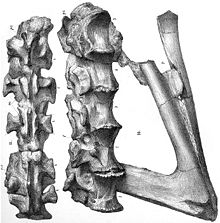Aristosuchus
| Aristosuchus Temporal range: Barremian
~ | |
|---|---|

| |
| Assigned elements as figured by Owen | |
| Scientific classification | |
| Kingdom: | Animalia |
| Phylum: | Chordata |
| Clade: | Dinosauria |
| Clade: | Saurischia |
| Clade: | Theropoda |
| Family: | †Compsognathidae |
| Genus: | †Aristosuchus Owen 1876 |
| Species: | †A. pusillus
|
| Binomial name | |
| †Aristosuchus pusillus Owen 1876
| |

Aristosuchus is a genus of small coelurosaurian dinosaur whose name was derived from the Greek ἄριστος (meaning bravest, best, noblest) and σουχος (the Ancient Greek corruption of the name of the Egyptian crocodile-headed god Sobek). It shared many characteristics with birds.
Description[]

Aristosuchus was a bipedal, meat-eating (carnivorous) theropod dinosaur. This predator is thought to have been about 2 metres (6.6 ft) and is estimated to have weighed about 30 kilograms (66 lb). According to Gregory S. Paul, its weight was 7 kilograms (15 lb).[1]
The femur of Aristosuchus has a wing-like anterior trochanter and a markedly reduced fourth trochanter.
Classification[]
Aristosuchus was originally named as a new species of Poekilopleuron, P. pusillus, from the Wessex Formation of the Isle of Wight. Woodward and Sherborn (1890) regarded Aristosuchus pusillus as being based on the same specimen that Reverend William D. Fox named Calamospondylus oweni in 1866, and many authors followed suit (some regarding C. oweni as a nomen nudum).[2][3][4][5][6][7][8][9] However, Naish (1999, 2002) showed that Calamospondylus was based on a different specimen than the Aristosuchus holotype based on letters of correspondence between Richard Owen and Reverend Fox as well as discrepancies in the original description.[10][11]
Naish (1999, 2002) placed Aristosuchus in Compsognathidae.[10][11] Aristosuchus is known from holotype NHMUK R.178: a sacrum, a pubis, a femur and a few vertebrae. Two ungual phalanges were found nearby, which may have been from the same animal and would suggest long claws.
Discovery[]

The type species, Aristosuchus pusillus, was described in 1876 by Richard Owen and named Poekilopleuron pusillus.[12] The specific epithet means "small" in Latin. Harry Govier Seeley (1839–1909) gave it the name Aristosuchus in 1887.[13]
It was found in the Wealden Group dating to the Early Cretaceous (Barremian) in England, on the Isle of Wight, i.e. from about 125 million years ago.
References[]
- ^ Paul, G.S., 2010, The Princeton Field Guide to Dinosaurs, Princeton University Press p. 122
- ^ A. S. Woodward and C. D. Sherborn. 1890. A Catalogue of British Fossil Vertebrata. Dulao & Company, London 1-396.
- ^ Swinton, W.E. 1936. The dinosaurs of the Isle of Wight. Proceedings of the Geologists’ Association, 47, 204–220.
- ^ Steel, R. 1970. Encyclopedia of Paleoherpetology, Part 14: Saurischia. Gustav Fischer Verlag, Stuttgart.
- ^ Norman, D.B. 1990. Problematic Theropoda: ‘Coelurosauria’. In (Weishampel, D.B., Dodson, P. & Osmolska, H.; eds) The Dinosauria. University of California Press, Berkeley, 280–305.
- ^ Kirkland, J.I., Britt, B.B., Whittle, C.H., Madsen, S.K. & Burge, D.L. 1998. A small coelurosaurian theropod from the Yellow Cat Member of the Cedar Mountain Formation (Lower Cretaceous, Barremian) of eastern Utah. New Mexico Museum of Natural History and Science Bulletin, 14, 239–248.
- ^ Galton, P. 1973. The femur of a small theropod dinosaur from the Lower Cretaceous of England. Journal of Paleontology, 47, 996–1001.
- ^ Blows, W.T. 1983. William Fox (1813–1881), a neglected dinosaur collector of the Isle of Wight. Archives of Natural History, 11, 299–313.
- ^ Norman, D.B. 1985. The Illustrated Encyclopedia of Dinosaurs. Salamander, London.
- ^ a b Naish, D. 1999. Fox, Owen and the small Wealden theropods Calamospondylus and Aristosuchus. Journal of Vertebrate Paleontology, 19 (Suppl. 3), 66.
- ^ a b NAISH, D. 2002. The historical taxonomy of the Lower Cretaceous theropods (Dinosauria) Calamospondylus and Aristosuchus from the Isle of Wight. Proceedings of the Geologists’ Association 113: 153–163.
- ^ Owen, R. (1876). "Supplement (No. VII) to the Monograph on the Fossil Reptilia of the Wealden and Purbeck Formations. (Poikilopleuron and Chondrosteosaurus)". Palaeontographical Society Monograph. 30: 1–7.
- ^ Seeley, H. G. (1887). "On Aristosuchus pusillus (Owen), being further notes on the fossils described by Sir R. Owen as Poikilopleuron pusillus, Owen". Quarterly Journal of the Geological Society of London. 43: 221–228. doi:10.1144/GSL.JGS.1887.043.01-04.22.
Further reading[]
- Naish, D. (2011). "Theropod dinosaurs". In Batten, D. J. (ed.). English Wealden Fossils. London: The Palaeontological Association. pp. 526–559.
- Naish, D. (2001). "The historical taxonomy of the Lower Cretaceous theropods (Dinosauria) Calamospondylus and Aristosuchus from the Isle of Wight". Proceedings of the Geologists' Association. 113: 153–163. CiteSeerX 10.1.1.394.8883. doi:10.1016/s0016-7878(02)80017-7.
- Compsognathids
- Barremian life
- Early Cretaceous dinosaurs of Europe
- Cretaceous England
- Fossils of England
- Fossil taxa described in 1876
- Taxa named by Harry Seeley













